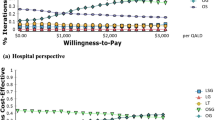Abstract
Background
The use of open tension-free techniques in hernia surgery seems to be superior to those techniques that apply tension to the suture line. However, the cost-effectiveness of tension vs. tension-free repairs has not been investigated before.
Methods
This study is a cost-effectiveness analysis within a randomized controlled clinical trial that compared open-tension (OT) versus mesh-plug tension-free (MPTF) hernia repair, with a 2-year follow-up for each patient. Between July 2002 and June 2003, 106 patients with inguinal hernia were randomized to either procedure. Main outcome measures included average surgical time, time to full recovery, pain visual analog scale, amount of analgesics required, off-work time, hospital stay, and heath-care costs.
Results
The average cost was $885.15 (95% CI $843.56–$926.74) and $837.66 (95% CI $796.42–878.89) USD for the OT and the MPTF herniorrhaphy, respectively (P < 0.05). Average yearly savings with the MPTF repair were calculated as $7,598.84 USD. Surgery time, time to full recovery, pain visual-analog scale, use of analgesics, off-work time, and hospital stay were significantly lower for the MPTF repair. Disability-adjusted life-years were reduced 56% with the MPTF repair, which represented a total savings of $12,656.60 USD with this procedure.
Conclusion
This controlled clinical trial demonstrates that the MPTF technique significantly decreases care costs in patients operated on for inguinal hernias.
Similar content being viewed by others
References
The Medical Research Council Laparoscopic Groin Hernia Trial Group (2001) Cost-utility analysis of open versus laparoscopic groin hernia repair: results form a multicentre randomized clinical trial. Br J Surg 88:653–661
Nyhus L (1989) The recurrent groin hernia: therapeutic solutions. World J Sur 12:541–544
Janu PG, Seller KD, Mangiante EC (1997) Mesh inguinal herniorrhaphy: a 10-year review. Am Surg 63:1065–1069
Barth RJ, Bauchard KW, Tosteson A et al (1998) Short-term outcome after mesh or Shouldice herniorrhaphy: a randomized, prospective study. Surgery 123:121–126
Heikkinen TJ, Haukipuro K, Leppälä J, Hulkko A (1997) Total cost of laparoscopic and Lichtenstein inguinal hernia repairs: a randomized prospective study. Surg Laparosc Endosc 7:1–5
Heikkinen TJ, Haukipuro K, Hulkko A (1998) A cost and outcome comparison between laparoscopic and Lichtenstein hernia operations in a day-case unit. A randomized prospective study. Surg Endosc 12:1199–1203
Rukow IM, Robbins AW (1995) Groin hernia. In: Cameron JL (ed) Current surgical therapy. Mosby, St Louis, 481 pp
Stroupe KT, Manheim LM, Luo P et al (2006) Tension-free repair versus watchful waiting for men asymptomatic or minimally symptomatic inguinal hernias: a cost-effectiveness analysis. J Am Coll Surg 203:458–468
Bay-Nielsen M, Nilsson E, Nordin P, Kehlet H (2004) Chronic pain after open mesh and sutured repair of indirect inguinal hernia in young males. Br J Surg 91:1372–1376
Cunningham J, Temple WJ, Mitchell P et al (1996) Cooperative hernia study. Pain in the postoperative patient. Ann Surg 224:598–602
Neumayer L, Giobbie-Hurder A, Jonasson O et al (2004) Open mesh versus laparoscopic mesh repair of inguinal hernia. N Engl J Med 350:1819–1827
Hynes DM, Stroupe KT, Luo P et al (2006) Cost effectiveness of laparoscopic versus open mesh hernia operation: results of a department of veterans affairs randomized clinical trial. J Am Coll Surg 203:445–447
Kald A, Anderberg B, Carlsson P et al (1997) Surgical outcome and cost-minimization-analyses of laparoscopic and open hernia repair: a randomized prospective trial with 1-year follow-up. Eur J Surg 163:505–510
Johansson B, Hallerbäck B, Glise H et al (1999) Laparoscopic mesh versus open preperitoneal mesh versus conventional technique for inguinal hernia repair. A randomized multicenter trial (SCUR Hernia Repair Study). Ann Surg 230:225–231
Wellgood J, Schulper MJ, Stroker D et al (1998) Randomized controlled trial of laparoscopic versus open mesh repair for inguinal hernia: outcome and cost. BMJ 317:103–110
Liem MSL, Haisema JAM, van der Graaf Y et al (1997) Cost effectiveness of extrapertioneal laparoscopic inguinal hernia repair: a randomized comparison with conventional herniorrhaphy. Ann Surg 226:676–688
Lawrence K, McWhinnie D, Goodwin A et al (1996) An economic evaluation of laparoscopic versus open inguinal hernia repair. J Public Health Med 18:41–48
Motson RW (2002) Why does NICE not recommended laparoscopic hernirrhaphy? BMJ 324:1092–1094
Liem M, Halsema JA, van der Graff Y, Schrijvers A, van Vroonhoven T (1997) Cost-effectiveness of extraperitoneal laparoscopic inguinal hernia repair: A randomized comparison with conventional herniorrhaphy. Ann Surg 226:668–676
Brooks DC (1994) A prospective comparison of laparoscopic and tension-free open herniorrhaphy. Arch Surg 129:361–366
The Medical Research Council Laparoscopic Groin Hernia Trial Group (1999) Laparoscpic versus open repair of groin hernia: a randomized comparison. Lancet 354:103–110
Murray CJL, Lopez AD (1994) Quantifying the burden of disease: the technical basis for disability–adjusted life years. Bull WHO 72:429–445
Author information
Authors and Affiliations
Corresponding author
Rights and permissions
About this article
Cite this article
Prieto-Díaz-Chávez, E., Medina-Chávez, J.L. & Anaya-Prado, R. A cost-effectiveness analysis of tension-free versus shouldice inguinal hernia repair: a randomized double-blind clinical trial. Hernia 13, 233–238 (2009). https://doi.org/10.1007/s10029-008-0461-2
Received:
Accepted:
Published:
Issue Date:
DOI: https://doi.org/10.1007/s10029-008-0461-2




